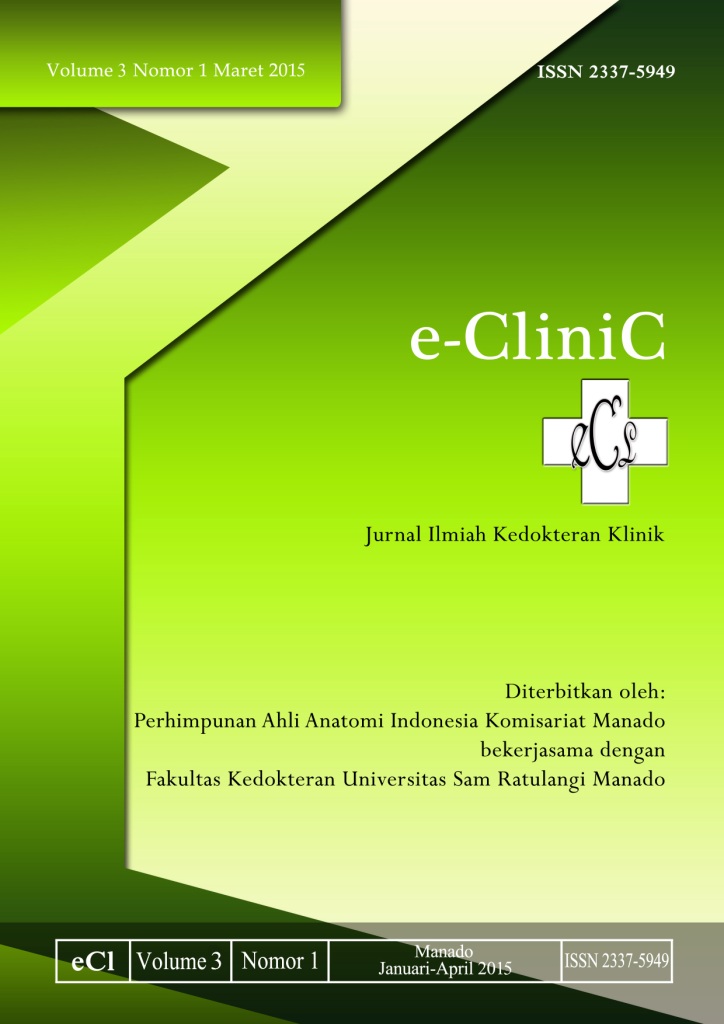PENGARUH LINGKUNGAN DAN TEMPAT TINGGAL PADA PENYAKIT ANAK UMUR 5 – 14 TAHUN DI KOTA BIAK TAHUN 2013
DOI:
https://doi.org/10.35790/ecl.v3i1.6427Abstract
Abstract: Malaria is a disease of the symptoms of acute or chronic infection caused by Plasmodium, characterized by recurrent fever, chills, sweating, anemia and hepatosplenomegali. In Indonesia, malaria is still a major infectious disease, especially the East part. The most frequently found plasmodia are Plasmodium falciparum and Plasmodium malaria vivax. Risk factors are malnutrition, the state of the neighborhood around the bush, rice fields, ditches or gutters with puddle air. According to the Biak Health Department in January-December 2012 there were 3608 cases of malaria in 190 villages and the most commonly found was Plasmodium vivax. This was a descriptive observational study using cross-sectional study design. This study was done once in every neighborhood with diagnosed malaria patients. Samples were children aged 5-14 years who were diagnosed with malaria in public hospitals and health centers in Biak during October to December 2013, and the parents approved the form of a questionnaire study. Conclusion: In Biak, boys aged 5-7 years had the highest percentage of malaria. Environmental factors that affected might be the condition of house ventilation, not using repellent or mosquito nets, opened water reservoirs, puddle areas, bushes, and landfills around the houses.
Keywords: malaria, children, environment
Abstrak: Malaria adalah penyakit infeksi akut atau kronis yang disebabkan oleh Plasmodium, ditandai dengan gejala demam rekuren, menggigil, berkeringat, anemia dan hepatosplenomegali. Di Indonesia, malaria masih merupakan penyakit infeksi utama khususnya dibagian Timur. Di kawasan Indonesia Timur plasmodia yang sering ditemukan ialah plasmodia falciparum dan vivax. Faktor risiko terkena malaria yaitu kekurangan gizi, keadaan lingkungan tempat tinggal disekitar semak belukar, persawahan, dan parit atau selokan dengan genangan air. Menurut Laporan Dinas Kesehatan Kota Biak penyakit malaria pada Januari-Desember tahun 2012 berjumlah 3608 kasus dengan jumlah 190 desa yang tertular. Malaria yang sering ditemukan yaitu plasmodium vivax. Penelitian ini bertujuan untuk mengetahui pengaruh lingkungan dan tempat tinggal pada penyakit malaria anak di Kota Biak, dengan rancangan potong lintang. Penelitian hanya dilakukan satu kali pada setiap lingkungan dan tempat tinggal pasien yang terdiagnosis malaria. Sampel ialah anak umur 5-14 tahun yang terdiagnosis malaria di RSU dan Puskesmas di Kota Biak selama bulan Oktober – Desember 2013 dan orang tua menyetujui penelitian berupa kuesioner. Simpulan: Di kota Biak, anak laki – laki berumur 5 – 7 tahun yang terbanyak terkena penyakit malaria. Hal ini mungkin disebabkan oleh faktor lingkungan antara lain ventilasi rumah yang tidak menggunakan kawat kasa, adanya genangan air dan terdapat semak- semak disekitar rumah, tidak memakai kelambu dan obat nyamuk saat tidur, tempat penampungan air yang tidak tertutup, dan tempat pembuangan sampah disekitar rumah.
Kata kunci: malaria, anak, lingkugan
Downloads
How to Cite
Issue
Section
License
COPYRIGHT
Authors who publish with this journal agree to the following terms:
Authors hold their copyright and grant this journal the privilege of first publication, with the work simultaneously licensed under a Creative Commons Attribution License that permits others to impart the work with an acknowledgment of the work's origin and initial publication by this journal.
Authors can enter into separate or additional contractual arrangements for the non-exclusive distribution of the journal's published version of the work (for example, post it to an institutional repository or publish it in a book), with an acknowledgment of its underlying publication in this journal.
Authors are permitted and encouraged to post their work online (for example, in institutional repositories or on their website) as it can lead to productive exchanges, as well as earlier and greater citation of the published work (See The Effect of Open Access).







